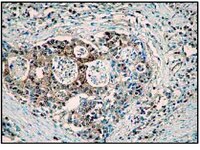Growth of primary embryo cells in a microculture system.
Villa M, Pope S, Conover J, Fan TH
Biomed Microdevices
12
253-61.
2010
Show Abstract
We present optimal perfusion conditions for the growth of primary mouse embryonic fibroblasts (mEFs) and mouse embryonic stem cells (mESCs) using a microfluidic perfusion culture system. In an effort to balance nutrient renewal while ensuring the presence of cell secreted factors, we found that the optimal perfusion rate for culturing primary embryonic fibroblasts (mEFs) in our experimental setting is 10 nL/min with an average flow velocity 0.55 microm/s in the microchannel. Primary mEFs may have a greater dependence on cell secreted factors when compared to their immortalized counterpart 3T3 fibroblasts cultured under similar conditions. Both the seeding density and the perfusion rate are critical for the proliferation of primary cells. A week long cultivation of mEFs and mESCs using the microculture system exhibited similar morphology and viability to those grown in a petri dish. Both mEFs and mESCs were analyzed using fluorescence immunoassays to determine their proliferative status and protein expression. Our results demonstrate that a perfusion-based microculture environment is capable of supporting the highly proliferative status of pluripotent embryonic stem cells. | 20012208
 |
The marine lipopeptide somocystinamide A triggers apoptosis via caspase 8.
Wrasidlo, W; Mielgo, A; Torres, VA; Barbero, S; Stoletov, K; Suyama, TL; Klemke, RL; Gerwick, WH; Carson, DA; Stupack, DG
Proceedings of the National Academy of Sciences of the United States of America
105
2313-8
2008
Show Abstract
Screening for novel anticancer drugs in chemical libraries isolated from marine organisms, we identified the lipopeptide somocystinamide A (ScA) as a pluripotent inhibitor of angiogenesis and tumor cell proliferation. The antiproliferative activity was largely attributable to induction of programmed cell death. Sensitivity to ScA was significantly increased among cells expressing caspase 8, whereas siRNA knockdown of caspase 8 increased survival after exposure to ScA. ScA rapidly and efficiently partitioned into liposomes while retaining full antiproliferative activity. Consistent with the induction of apoptosis via the lipid compartment, we noted accumulation and aggregation of ceramide in treated cells and subsequent colocalization with caspase 8. Angiogenic endothelial cells were extremely sensitive to ScA. Picomolar concentrations of ScA disrupted proliferation and endothelial tubule formation in vitro. Systemic treatment of zebrafish or local treatment of the chick chorioallantoic membrane with ScA resulted in dose-dependent inhibition of angiogenesis, whereas topical treatment blocked tumor growth among caspase-8-expressing tumors. Together, the results reveal an unexpected mechanism of action for this unique lipopeptide and suggest future development of this and similar agents as antiangiogenesis and anticancer drugs. Full Text Article | 18268346
 |











